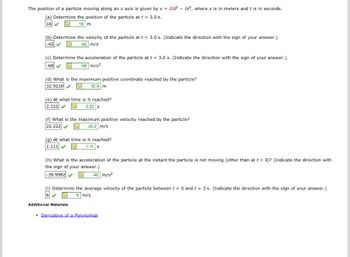
College Physics
11th Edition
ISBN: 9781305952300
Author: Raymond A. Serway, Chris Vuille
Publisher: Cengage Learning
expand_more
expand_more
format_list_bulleted
Concept explainers
Topic Video
Question
Can you help part a through I show all work please

Transcribed Image Text:The position of a particle moving along an x axis is given by x = 201²- 62³, where x is in meters and t is in seconds.
Determine the position of the particle at t = 3.0 s.
18 m
18
(b) Determine the velocity of the particle at t = 3.0 s. (Indicate the direction with the sign of your answer.)
-42 m/s
(c) Determine the acceleration of the particle at t = 3.0 s. (Indicate the direction with the sign of your answer.)
-68
-68 m/s²
(d) What is the maximum positive coordinate reached by the particle?
32.9218
32.9 m
(e) At what time is it reached?
2.222
2.22 S
(f) What is the maximum positive velocity reached by the particle?
22.222
22.2 m/s
(g) At what time is it reached?
1.111
1.11 s
(h) What is the acceleration of the particle at the instant the particle is not moving (other than at t = 0)? (Indicate the direction with
the sign of your answer.)
-39.9992
40 m/s2
(i) Determine the average velocity of the particle between t = 0 and t = 3 s. (Indicate the direction with the sign of your answer.)
6 m/s
Additional Materials
• Derivative of a Polynomial
Expert Solution
This question has been solved!
Explore an expertly crafted, step-by-step solution for a thorough understanding of key concepts.
Step by stepSolved in 3 steps with 1 images

Knowledge Booster
Learn more about
Need a deep-dive on the concept behind this application? Look no further. Learn more about this topic, physics and related others by exploring similar questions and additional content below.Similar questions
- Please Answer part D only. questions A,B,C are just there as context should it be needed.arrow_forwardHello, can you help me with this problem, all the parts, provide in-depth work. There are 4 total parts I attached them as 2 different screenshots, can you also make sure to make clear what the answer is.arrow_forwardPlease show clear, complete, organized and correct work or reasoning for each question.arrow_forward
- 1 A block is placed on an elevator platform that moves downward with decreasing speed. Consider the time interval At, in which the speed of the platform changes from v, to zero. Decreasing speed (from v, to zero) Block a. In the space provided, sketch a free-body diagram for the block. b. Is the net work done on the block positive, negative, or zero? Platform For each force on the free-body diagram, state whether the work done on the block by that force is positive, negative, or zero. Explain. Free-body diagram for block Rank the works you identified above in order of decreasing absolute value. Explain. c. Consider reference frame R, moving downward with constant speed v.. In reference frame R: Direction of acceleration Direction of i. In the spaces provided, draw arrows to indicate the direction of the velocity and the acceleration of the block in reference frame R during the interval At,. Explain. velocity of block of block ii. In reference frame R: • is the block speeding up,…arrow_forwardI would like a step by step process with formulas used and free body diagram, along with therefore statementsarrow_forwardPlease show all work and answer all partsarrow_forward
- Mike's car, which weighs 1,000 kg, is out of gas. Mike is trying to push the car to a gas station, and he makes accelerate 0.05 m/s/s. Using Newton's Second Law, you can compute how much force Mike is applying to the car. If the gas station is 200 meters away and the friction force against him is exactly equal to the force applied in part a, how much work did Mike do?arrow_forwardThe small cart has a speed 16 ms at point A. Neglecting friction, determine its speed at point B. Round your result to the nearest integer. 1.8 m Barrow_forwardPlease show your work, thank you :)arrow_forward
arrow_back_ios
arrow_forward_ios
Recommended textbooks for you
 College PhysicsPhysicsISBN:9781305952300Author:Raymond A. Serway, Chris VuillePublisher:Cengage Learning
College PhysicsPhysicsISBN:9781305952300Author:Raymond A. Serway, Chris VuillePublisher:Cengage Learning University Physics (14th Edition)PhysicsISBN:9780133969290Author:Hugh D. Young, Roger A. FreedmanPublisher:PEARSON
University Physics (14th Edition)PhysicsISBN:9780133969290Author:Hugh D. Young, Roger A. FreedmanPublisher:PEARSON Introduction To Quantum MechanicsPhysicsISBN:9781107189638Author:Griffiths, David J., Schroeter, Darrell F.Publisher:Cambridge University Press
Introduction To Quantum MechanicsPhysicsISBN:9781107189638Author:Griffiths, David J., Schroeter, Darrell F.Publisher:Cambridge University Press Physics for Scientists and EngineersPhysicsISBN:9781337553278Author:Raymond A. Serway, John W. JewettPublisher:Cengage Learning
Physics for Scientists and EngineersPhysicsISBN:9781337553278Author:Raymond A. Serway, John W. JewettPublisher:Cengage Learning Lecture- Tutorials for Introductory AstronomyPhysicsISBN:9780321820464Author:Edward E. Prather, Tim P. Slater, Jeff P. Adams, Gina BrissendenPublisher:Addison-Wesley
Lecture- Tutorials for Introductory AstronomyPhysicsISBN:9780321820464Author:Edward E. Prather, Tim P. Slater, Jeff P. Adams, Gina BrissendenPublisher:Addison-Wesley College Physics: A Strategic Approach (4th Editio...PhysicsISBN:9780134609034Author:Randall D. Knight (Professor Emeritus), Brian Jones, Stuart FieldPublisher:PEARSON
College Physics: A Strategic Approach (4th Editio...PhysicsISBN:9780134609034Author:Randall D. Knight (Professor Emeritus), Brian Jones, Stuart FieldPublisher:PEARSON

College Physics
Physics
ISBN:9781305952300
Author:Raymond A. Serway, Chris Vuille
Publisher:Cengage Learning

University Physics (14th Edition)
Physics
ISBN:9780133969290
Author:Hugh D. Young, Roger A. Freedman
Publisher:PEARSON

Introduction To Quantum Mechanics
Physics
ISBN:9781107189638
Author:Griffiths, David J., Schroeter, Darrell F.
Publisher:Cambridge University Press

Physics for Scientists and Engineers
Physics
ISBN:9781337553278
Author:Raymond A. Serway, John W. Jewett
Publisher:Cengage Learning

Lecture- Tutorials for Introductory Astronomy
Physics
ISBN:9780321820464
Author:Edward E. Prather, Tim P. Slater, Jeff P. Adams, Gina Brissenden
Publisher:Addison-Wesley

College Physics: A Strategic Approach (4th Editio...
Physics
ISBN:9780134609034
Author:Randall D. Knight (Professor Emeritus), Brian Jones, Stuart Field
Publisher:PEARSON